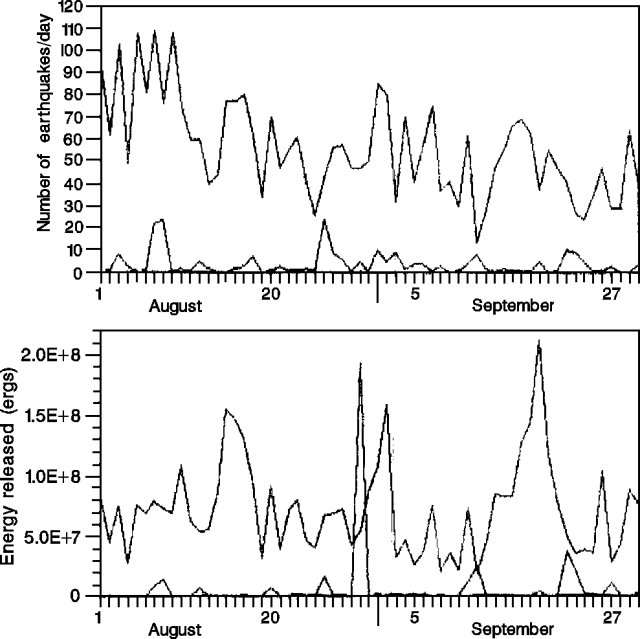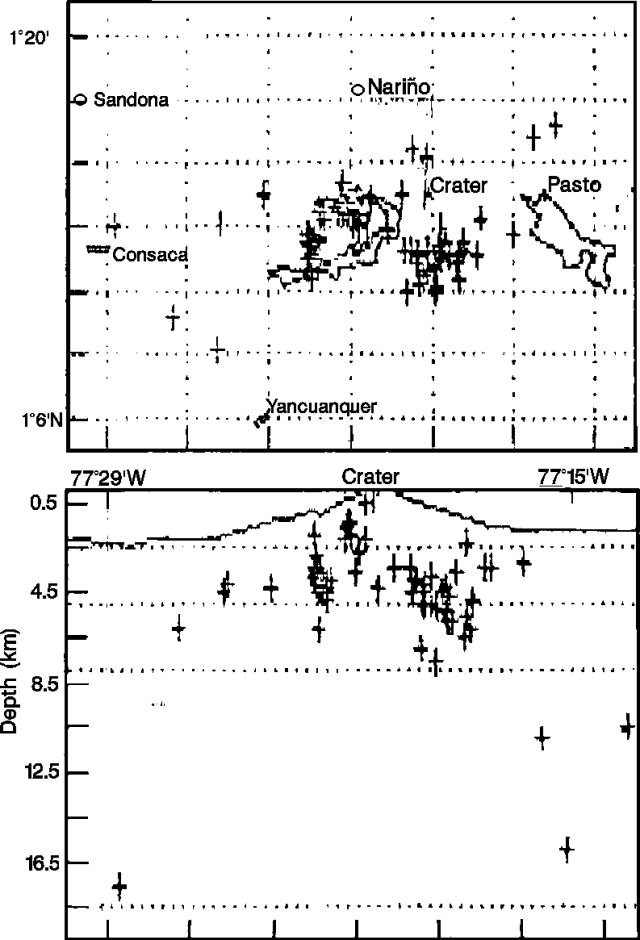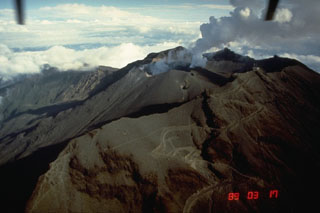Report on Galeras (Colombia) — September 1990
Bulletin of the Global Volcanism Network, vol. 15, no. 9 (September 1990)
Managing Editor: Lindsay McClelland.
Galeras (Colombia) Fissure opens in crater; ash emissions; many intense A-type earthquakes
Please cite this report as:
Global Volcanism Program, 1990. Report on Galeras (Colombia) (McClelland, L., ed.). Bulletin of the Global Volcanism Network, 15:9. Smithsonian Institution. https://doi.org/10.5479/si.GVP.BGVN199009-351080
Galeras
Colombia
1.22°N, 77.37°W; summit elev. 4276 m
All times are local (unless otherwise noted)
An E-W-trending fissure with intense and audible gas emission formed in the W sector of the main crater. The fissure was 12 m long with 130°C fumaroles when first noted at the beginning of September, but grew to 36 m in length with 738°C fumaroles by the end of the month. Sulfur deposits and incandescence were visible. Gas analyses of pre-existing fumaroles revealed a relative decrease in the concentration of sulfur species and an increase in CO2. The fumaroles in the SW sector had a strong magmatic component, while the N fumaroles were predominantly hydrothermal.
Ash emissions occurred on 2, 11, and 24 September and were accompanied by near-simultaneous (within 10-40 seconds) long-period earthquakes or tremor episodes. The number and intensity of long-period earthquakes gradually decreased following a minor peak in early August (15:8 and figure 27). These events, occasionally linked to tremor episodes, were shallow (<2.0 km depth) and centered beneath to slightly NW of the crater.
 |
Figure 27. Seismicity at Galeras, August-September 1990. The lower line shows high-frequency events, the upper line low-frequency and long-period activity. Courtesy of INGEOMINAS. |
There were a large number of intense high-frequency earthquakes, several felt, during September. The earthquakes were concentrated in two focal areas, one W of the crater, the other 2-4 km E (depths of 2.5-7.0 km; figure 28). Magnitude 2.7 and 2.8 events occurred at the E focus on 11 and 12 September, respectively. The E focus was also the site of a swarm of 8 high-frequency earthquakes (M 1.8-2.5) during a 1.5-hour period 22 September, and a M 3.6 earthquake on 30 August.
 |
Figure 28. Epicenter map (top) and E-W cross-section showing focal depths (bottom) of 75 high-frequency earthquakes recorded at Galeras, September 1990. Courtesy of INGEOMINAS. |
Deformation measurements during September did not show any significant changes. Dry tilt data showed low levels of deformation with a slight inflationary trend. Periodic changes of 2-6 µrad were recorded by EDM, coincident with increases in seismicity on 4, 9, 12, and 22 September.
Geological Summary. Galeras, a stratovolcano with a large breached caldera located immediately west of the city of Pasto, is one of Colombia's most frequently active volcanoes. The dominantly andesitic complex has been active for more than 1 million years, and two major caldera collapse eruptions took place during the late Pleistocene. Long-term extensive hydrothermal alteration has contributed to large-scale edifice collapse on at least three occasions, producing debris avalanches that swept to the west and left a large open caldera inside which the modern cone has been constructed. Major explosive eruptions since the mid-Holocene have produced widespread tephra deposits and pyroclastic flows that swept all but the southern flanks. A central cone slightly lower than the caldera rim has been the site of numerous small-to-moderate eruptions since the time of the Spanish conquistadors.
Information Contacts: INGEOMINAS-OVP.

